Growing up in Parkdale in the 1940s
My family moved to Parkdale in September 1942. My father was in the army and my mother decided to live outside the urban area of Melbourne because of the threat of a Japanese invasion. She had looked at houses in Mentone and Cheltenham but chose McBean Street(now Birdwood Street) because of its proximity to the beach, railway station and the shopping centre. She bought the house from Mrs. Lesoueff for £750, with repayments of 7/6 a week.
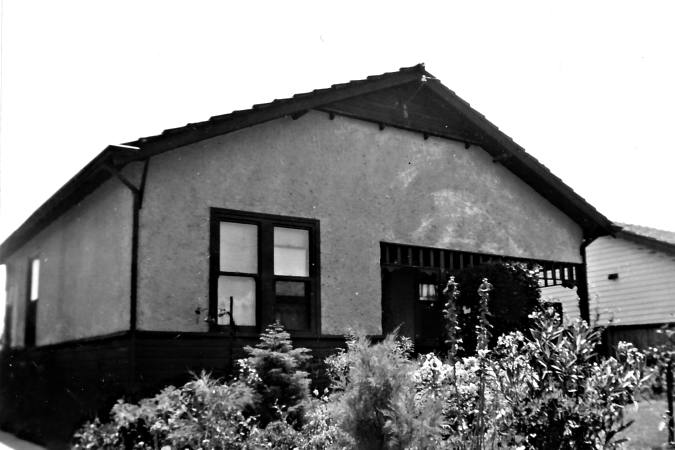
11 Birdwood Street, Parkdale 1974.
The house at 11 McBean Street seemed to be surrounded by pine trees. A ragged hedge of ti-tree and coprosma spilled onto the unmade foot path. There was no garden and the coastal grass and pig-face covered the sandy soil. The house was cottage style, half weatherboard and half rough cast. It had four main rooms, an annexe at the rear for a kitchen and another small outbuilding with a copper and concrete wash troughs. The lavatory was on the back side fence so that the dunny man could have access from the road. He visited us once a week and at Christmas Mum would write him a poem in appreciation and leave him a one pound note. On the other side of the house at the end of the drive, was Bob’s sleep out. Before we left Orrong Road, Mum had bought a prefabricated room, which was Bob’s bedroom-cum- study. At the time, he was at Melbourne Teachers’ College. The portable was shifted to Parkdale and re-constructed on site. It made a very comfortable room, and in the summer the perfume of the Blackboy rose, which Mum had planted, would come wafting in the little window near the bed.
In the middle of the back yard we discovered that the previous tenant had constructed an air-raid shelter which was a large hole about six foot deep and ten foot long and five foot wide. Wooden steps led into the shelter and the whole thing was covered with sheets of tin. We were very fortunate that we never had an air raid because we would all have been drowned, as the seepage from the rest of the street had filled the hole. Mum forbade us to go near it, much to my chagrin. An enormous Aleppo pine tree was at the extreme rear of the block. It was bigger than all the other trees and stood grandly at the junction of the other neighbours’ fences. This tree became a tree house, a plane, a ship or anything one desired. There was always the smell of turpentine resin and a sticky gum on one’s hands after playing in the pines.
The Street
From Miss Sugden’s shop on the corner of Beach Roadand McBean Street, there were four houses on our side to Number 11; the shop, Miss Sugden’s mother, the Jones, the Allens, the Hallidays and then us. On the same side of the road past us were the O’Neills, the Lawsons, two holiday houses, the Johns, the Healys and then the lane way which led to Antibes Street .On the other side of the street were the Sullivans next to the lane, then the Campells, the big vacant block, (which later became a playground), the Smiths, Mrs. McDonald’s boarding house, the Farrows, and facing the beach, a large modern white house which I called the rich people’s place. This was the little world we entered in 1942. Of course there were other people but they did not come into the gambit of my life for a few years. My mates were Frank, John and Pat O’Neill, Gordon Halliday and Don Lawson.
The first summer at Parkdale was a glorious time of sun and happiness. Mum and Dad got rid of the pine trees except the big one on the rear fence. Mum had the whole back yard made into a vegetable garden, a drive was concreted and a path was made to the front door. The vegetable garden was a joy and I can still remember the taste of the sweet corn plucked fresh and eaten with plenty of salt, pepper and lashings of butter. Mum bought some fowls and we always had plenty of eggs even when they went off the lay, as Mum would preserve them in Keepegg, a sort of Vaseline coating. Occasionally these eggs were of a dubious freshness, and it was essential to break them into a cup before using them. We always had one bastard of a rooster who would attack me when I fed the chooks. I hated it and I would refuse to feed them if he was on the warpath. However, having the old devil rooster meant that we often had clucky chooks and chickens. Mum also bought day old chicks and reared them in the washhouse under artificial light to keep them warm .You might imagine that we had thousands of chooks, but not really, because heads would roll in time for the Sunday tea, or when money was short. Mum was the executioner, plucker, cleaner and cook. The smell of wet feathers still reminds me of execution days.
From 1942, rationing was introduced into Australia, and this made it essential to provide as much home produce as possible. Most backyards had their vegetable gardens and most had a few chooks. Meat, dairy produce and tinned foods were rationed as were sugar, tea and coffee. Clothes and drapery were strictly controlled by coupons, but we never had much money to spend on luxury items like new dresses or sheets. When our sheets became worn, Mum would turn the middle to the outside using the Singer treadle sewing machine. The meat ration must have been ample because we often had roast lamb for Sunday tea. Then it would become cold meat and gravy on Monday, shepherd’s pie on Tuesday and rissoles on Wednesday. I can’t remember much beef being cooked except corned beef. The main staple seemed to be lamb – lamb’s fry, shanks, chops, cutlets and lamb in parsley sauce. Rabbit was often on the menu and we had fish on Fridays [lovely boneless flake].
Shopping
We did not have a car so Mum did all her shopping at Parkdale, usually on Saturday morning. All the shops were on the south side of the railway line along Como Parade. On the corner of Alameda Street was the lending library. We changed books once a week and Mum would have read three books in that time, mostly detective novels. Erle Stanley Gardner and Edgar Wallace were favourites. I liked Joan Butler and Noel Godber. Next to the library was a dress shop, then the Post-Office cum milk bar. The delicatessen next door was a favourite of mine because I would spend my threepenny pocket money on big green olives which were fished out of a glass bottle on the counter. The butcher’s shop was visited every week and the Thompsons were the largest roundest, jolliest people you could ever meet. The floor of the shop was covered with fresh sawdust and the meat was cut on a large pine chopping block after the carcass was brought from the cool room. In the first few years, meat coupons were handed over and calculations were made on what could be purchased. After a dress shop and a grocer shop came the newsagent. I loved this shop because of the comics which could be bought. Mum collected the Sun in the morning or the Herald at night. I liked the Sun because it had Corinella’s page for children and I became a Sunbeamer. I won 2/6 for a story which I had written. Most of the comics I liked came from England and so were very scarce and often months out of date. Film Fun, Radio Fun, Hotspur and Champion were all British. The only Australian comic I can remember was Ginger Meggs and I was never very interested in that. However, my favourite was Buck Rogers that hero of outer space. The comics would be swapped up and down the street and they were well read. Next to the newsagent was the fruit shop and then the men’s barber with its red and white pole outside the door. The shoe shop was a very important place for families with school children. All shoes had to be repaired, resoled, reworn and then passed on to the next child in line. If money was short, Mum would get out the cobbler’s last and put chromide soles on the shoes and little metal tips on the heels.
Marvel Barnes Haberdashery Emporium was a shop full of wonders and delights. A cylindrical tube would shoot the cash and the docket from the counter to Mr. Barnes who was sitting aloof and aloft in control of his office. It was wonderful to watch that flying bullet discharged by the very superior sales ladies. Anything could be bought in this treasure house of bits and bobs; providing you had the money and the coupons.
The fish shop and another milk bar completed the Como Parade side of the street. The hardware shop was around the corner in Parkers Road.
The other two shops we frequented were Miss Sugden’s on the corner of our street and Beach Road and Mr. Harry’s grocer shop on Beach Road near Antibes Street. At Miss Sugden’s shop we bought extra milk and cream and home made penny ice blocks. Mr Harry’s shop had wooden steps leading into the shop itself and it smelt of flour, biscuits and spices. Mum bought the bran and pollard for her chooks here and I loved watching the weighing on the big scales and getting some broken biscuits as a reward.
During that first summer, the ice cream man used to push his cart up our unmade street and ring his bell to announce his coming. We would rush out, and if we were lucky and Mum had the money, we would get a penny scoop of homemade vanilla ice cream. The milk was delivered to the front gate. In the first year, we would leave out a billy and the milkman would leave the appropriate amount. Later, the milk was delivered in pint bottles. Because the milk was not homogenized, there would always be a delicious head of cream on top of the bottle, to be savoured by the lucky first drinker unless we were told to shake the bottle. The baker in a horse and cart delivered the bread three times a week. The horse drawn carts were a bonus for the garden as we would collect the droppings. Mum also gathered seaweed, washed the salt from it and used it as mulch.
I cannot remember where the chemist shop was located in the street. We never seemed to have many medicines in the house. Laxettes were given for constipation, aconites for high temperatures and Hypol for everything. I think Mum and Dad only took Ford Pills and Bex powders. When head lice became a threat, as they did every year at Primary school for girls with long plaits, Mum would wash my hair with Timid Joe dog soap and apply Podec Pomade, then comb my hair with a fine toothcomb. When I had a boil on my back, Mum applied Schreck’s poultice on an Arum lily leaf. Splinters were drawn out with a soap and sugar poultice. I had not been to a doctor until I was 20 except for immunization for typhoid fever and polio. The first dentist I remember going to was Mr. Valentine Bloggs at Caulfield. I loved his name and it used to roll off my tongue with pleasure. Mr. Challen became our dentist when we shifted to Parkdale and both my brother and I went to school with the Challen boys – Bob at University High School and I was with Michael at Mordialloc and at Frankston High School.
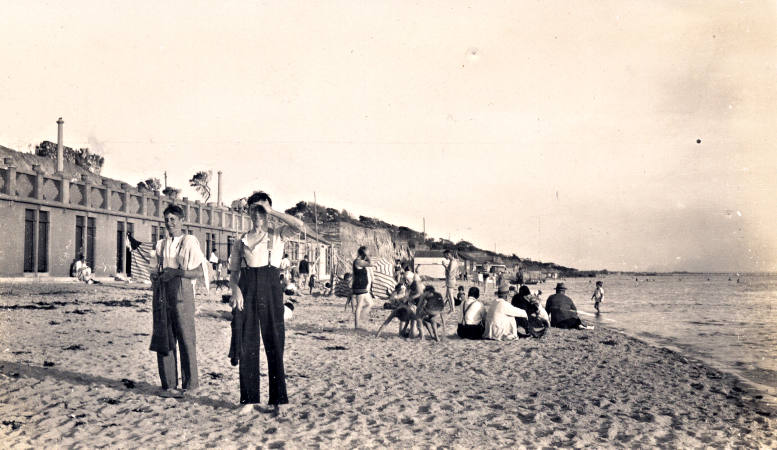
Bathing Boxes at Parkdale Beach, c1935. Courtesy Mordialloc and District Historical Society.
The Beach
At the bottom of McBean Street and across Beach Road was our sea front, accessible by a curving track down the cliff. This man- made track was fun to ride down on bikes but for anyone who was fond of adventure, there were steep cuts in the eroded cliffs to be negotiated. (Good fun when wet and slippery and the orange clay would stick to hands, shoes and clothes.) In 1942, there were remains of six old concrete bathing boxes at the foot of the track on the Mordialloc side. These had all but been demolished by storms and were in a sorry state of disrepair. I suppose they would have been about 7 or 8 feet height above the sand. One of the bravest things one could do was to jump from the roof onto a carefully constructed sandcastle below. Jutting into the water about ten feet from the shore was a storm water drain. When it rained, water would gush from its mouth in a lovely brown, muddy stream. We always swam and sat on the left of this drain on the Mordialloc side, where the sea seemed to be clearer with less seaweed. At the next street, Monaco Street, there were stairs leading down to the beach rather than a path. At the foot of these stairs was a big configuration of rocks. There were many little pools in these rocks at low tide and these were the homes of tiny crabs, sea anemones and winkles. On the rocks farther out there were mussels, and when I could swim, the O’Neill’s and I would gather these at low tide in Hessian bags. Mum would boil them in the copper and she and Dad would eat them with vinegar and bread and butter. On summer nights, flounders could be caught on the shoreline with spears and the use of a torch. On calm dark nights the shoreline would come alive with sparkling phosphorous grains of sand. It was quite magical.
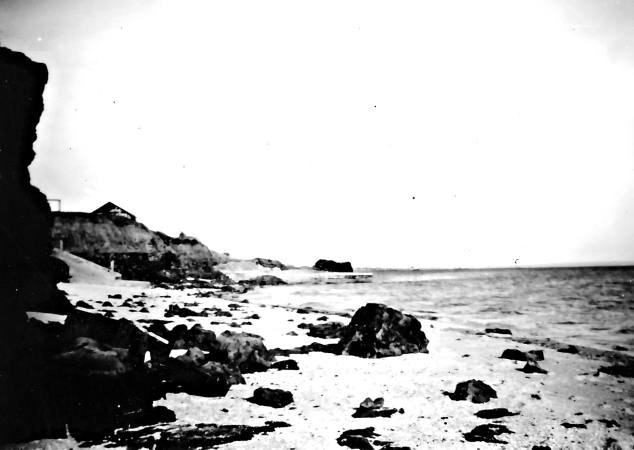
Parkdale beach with concrete ramp, c1942. Courtesy Nancye Heighway.
No wonder the sea was always a source of wonder and delight. When it was calm, it was like an opaque sheet of glass. When it was stormy in winter, it was like an angry animal. Strange oddments would be thrown from its depths; old shoes, bottles bits of driftwood and lots of seaweed.
The steps leading to the beach from Antibes Street marked the beginning of the concrete promenade which led to the Mentone Pier and the old Mentone Baths. I believe that the promenade was built during the depression to give work to the unemployed. The Mentone Pier and the Baths were damaged by storms.
The cliffs along the beach were covered in thick ti-tree and coprosma scrub and there were many winding tracks leading through the bushes which were ideal for bike rides. During that first summer, Mum and the neighbours would spend the days on the beach and I learnt to go into the water without fear, then to put my head under, and then wonder of wonders, to open my eyes to the underwater life.
Next to Miss Sugden’s shop was my magical house, the house of my dreams. It was a two story grey stone house and was set in about an acre of wild garden. When we went to live at Parkdale, it had been vacant for several years and its empty windows stared out over the seas. I thought of them as “magic casements opening on the foam of perilous seas, in fairy lands forlorn”. The garden was a wild tangle of coprosma, ti-tree, pampas grass, briar roses and weeds. I planned how I would bring that garden under control and refurbish the house to its former glory. It was pulled down in the 1950s and a mediocre cream brick house replaced that magical old building. It has always lived in my memory and I would love to know its history
.
The War
Most of the men in our street were either in the services or were too old for the call up. Dad and Mr. O’Neill were in the army, the Johns boys were in the Navy, Don Lawson’s father was in New Guinea and he was presumed dead on the Kokoda Trail. One of the American visiting servicemen had offered me a stick of chewing gum but much as I wanted to take it, I remembered not to take it. “Don’t talk to strangers” Mum said, “Particularly Americans.” I think she thought they were all in the white slave business. But I think she was scared because one of their number had been imprisoned after a series of grisly murders in Melbourne. Chewing gum was very scarce and we would ride our bikes for miles to a shop that had received its ration.
Labour was very short and women were urged to take jobs to help the war effort. The money was very handy too although they were only paid a percentage of the men’s wage. Mrs.O’Neill, Mrs. Lawson and Mum were employed by Prince’s Laundry in Warrigal Road. They walked the two miles there and two miles back every day. They worked from 8 to 5 for five days a week. There were very few cars in our street and shanks pony was our transportation. The Prince family lived in a large house on the Mentone side of Como Parade and I learnt the piano from Miss Prince. As a child, I don’t think that the war impinged on my life very much, I couldn’t remember a time when things had not been short. There was always enough to eat and Mum had a store cupboard of food put away in case we were invaded. I have retained this principle of having something put away for disasters and my pantry is always well stocked.
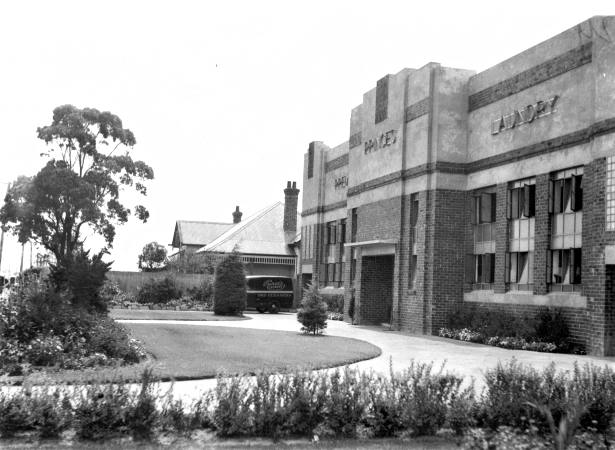
Princes Laundry, Warrigal Road, Mentone, 1958. Courtesy Mordialloc and District Historical Society.
It is hard for people nowadays to imagine life without television. We had the wireless to keep us informed on the news and there were plenty of other serials and stories to listen to. The news would come on at 7 o’clock and this was preceded by “Martin’s Corner” and “Dad and Dave.” After the news we would listen to “When a Girl Marries.” We had no telephone and the nearest one was in the shopping area near the Post Office. If Mum wanted to get in touch with the Aunties, she would drop them a letter or send a telegram if it was urgent. Knitting was very popular and we would either be knitting squares to make rugs for soldiers or fancy jumpers for ourselves if the wool was available. There were always books to read. I was lucky because Bob, my brother, was an avid reader and had been given lots of books before the war. Our houses have always been packed with books and I cannot imagine life without them. I am very glad that I grew up when there was no television. My favourite books were Swiss Family Robinson and Robinson Crusoe, The Golden Treasury Books with their stories of Greece and Rome, Peter Pan (although I cried when ever I read that). Later my reading would take me into the wonderful world of Arthur Ransome’s Lake District and the Swallows and Amazons.
During the summer holidays, if the weather was inclement and we could not spend the time on the beach, we would play endless games of Monopoly. We only had one board for all the families, so we would gather in someone’s house and squat on the floor and squabble and laugh for hours at a time. Mayfair and Vine Street were names we bandied about although we had no idea where they were. The days were never long enough and I cannot remember ever being bored, in fact I don’t think that the word existed in those days.
Parkdale State School
After the September holidays, in1942, I started school at Parkdale. It was a big change from the two-story red brick Hawksburn to the much smaller school on Point Nepean Road. I was always scared and very nervous of new people and new situations, but I suppose all children become pragmatic when faced with something they cannot change. My teacher that year was Mrs. Warner. I had never been taught by a ‘Mrs.’ before but the war had brought back many married women teachers and they were never to leave the profession again. It must have been a saving for the Government at the time, as women received only 3/4 of a man’s wage. In the teaching profession the only promotion for a woman was to become an Infant Mistress. Mrs. Warner was what is called now, a good old-fashioned no nonsense teacher, very strong on spelling, tables, and mental arithmetic.
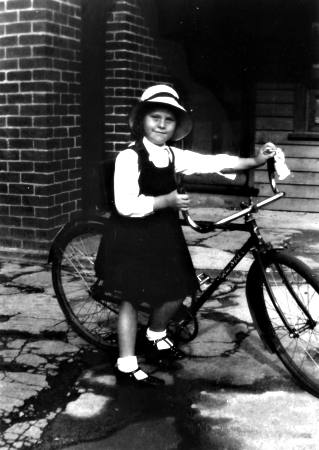
Nancye Thomas with her bicycle, c1942.
I suppose the school was about two kilometres from our house and it had to be walked every day. It was a long walk but time was not important and Mum did not get home till five o’clock. I think in the sixth grade I was allowed to ride my bike but I don’t think distances worried any one then; there was so much to look at. We would go up McBean Street to the Corso then on to Alameda Street, along the shops, across the railway line and up Parkers Road to the Highway. There were no lollypop ladies in those days and we were always careful crossing the Highway as Mrs. Lawson’s daughter Dorothy had been killed on that road. The traffic was so slight that I am amazed how it could happen.
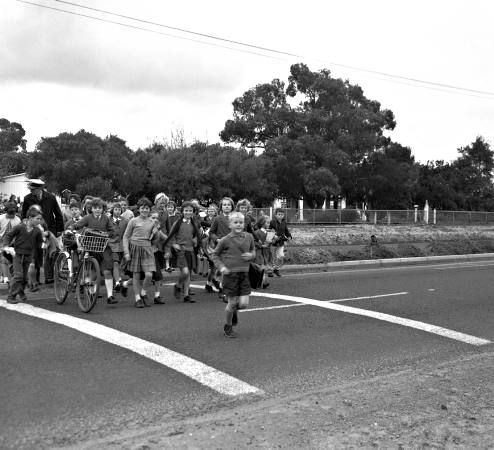
Children from Parkdale Primary School crossing Nepean Highway, 1962. Courtesy Leader Collection.
The school was set in ti-tree bush land and there were plenty of trees to sit under. I remember when I was in the Girl Guides we went a little way past the school grounds for our camp. That was where I learnt to cook sausages in banana skins. I don’t think they were a great success. It was very much a country school with few students and probably six teachers. I found it very small after the two-storied Hawksburn school and I really enjoyed the fact that I had much more freedom going and coming. No more buses or trams to worry about.
In grade 6 my teacher was Mr. Venn. His was a composite class of Grades 6, 7, and 8 and Grade 8 was the Merit year after which the pupils could leave school. There was no certainty that a pupil would advance to High School and at the end of Grade 6 an entrance exam was sat to choose the incomers to Mordialloc Chelsea High School. I was fortunate to pass this test and had five very happy years at this school, after which I finished my sixth year of secondary education at Frankston High school.
